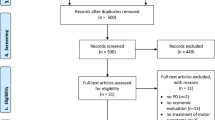Abstract
Background
Value of information analysis provides a framework for the analysis of uncertainty within economic analysis by focussing on the value of obtaining further information to reduce uncertainty. The mathematical definition of the expected value of perfect information (EVPI) is fixed, though there are different methods in the literature for its estimation. In this paper these methods are explored and compared.
Methods
Analysis was conducted using a disease model for Parkinson’s disease. Five methods for estimating partial EVPIs (EVPPIs) were used: a single Monte Carlo simulation (MCS) method, the unit normal loss integral (UNLI) method, a two-stage method using MCS, a two-stage method using MCS and quadrature and a difference method requiring two MCS. EVPPI was estimated for each individual parameter in the model as well as for three groups of parameters (transition probabilities, costs and utilities).
Results
Using 5,000 replications, four methods returned similar results for EVPPIs. With 5 million replications, results were near identical. However, the difference method repeatedly gave estimates substantially different to the other methods.
Conclusions
The difference method is not rooted in the mathematical definition of EVPI and is clearly an inappropriate method for estimating EVPPI. The single MCS and UNLI methods were the least complex methods to use, but are restricted in their appropriateness. The two-stage MCS and quadrature-based methods are complex and time consuming. Thus, where appropriate, EVPPI should be estimated using either the single MCS or UNLI method. However, where neither of these methods is appropriate, either of the two-stage MCS and quadrature methods should be used.



Similar content being viewed by others
References
Dakins, M.E., Toll, J.E., Small, M.J.: Risk-based environmental remediation: decision framework and role of uncertainty. Environ. Toxicol. Chem. 13, 1907–1915 (1995)
Felli, J.C., Hazen, G.B.: Sensitivity analysis and the expected value of perfect information. Med. Decis. Making. 18, 95–109 (1998)
Felli, J.C., Hazen, G.B.: A Bayesian approach to sensitivity analysis. Health. Econ. 8, 263–268 (1999)
Claxton, K., Posnett, J.: An economic approach to clinical trial design and research priority-setting. Health. Econ. 5, 513–524 (1996)
Chilcott, J., Brennan, A., Booth, A., Karnon, J., Tappenden, P.: The role of modelling in prioritising and planning clinical trials. Health. Technol. Assess. 7, 1–125 (2003)
Brennan, A.B., Chilcott, J.B., Kharroubi, S., O’Hagan, A.: Calculating expected value of perfect information: resolution of conflicting methods via a two level Monte Carlo approach. In: Proceedings of the 24th Annual Meeting of SMDM, Washington (2002)
Brennan, A.B., Chilcott, J.B., Kharroubi, S., O’Hagan, A.: A two level Monte Carlo approach to calculation expected value of sample information: how to value a research design. In: Proceedings of the 24th Annual Meeting of SMDM, Washington (2002)
Coyle, D., Buxton, M.J., O’Brien, B.J.: Measures of importance for economic analysis based on decision modeling. J. Clin. Epidemiol. 56, 989–997 (2003)
Coyle, D., Barbeau, M., Baladi, J.F.: Bayesian economic analysis of treatment with entacapone for Parkinson’s disease patients in Canada. In: Proceedings of the Society of Medical Decision Making, Philadelphia (2001)
Claxton, K., Neumann, P.J., Araki, S., Weinstein, M.C.: Bayesian value of information analysis. An application to a policy model of Alzheimer’s disease. Int. J. Technol. Assess. Health. Care. 17, 38–55 (2001)
Fenwick, E., Claxton, K., Sculpher, M., Briggs, A.: Improving the efficiency and relevance of health technology assessment: the role of iterative decision analytic modelling. CHE Discussion Paper 179. University of York, York (2000)
Coyle, D., Barbeau, M., Guttman, M., Baladi, J.F.: The economic evaluation of pharmacotherapies for Parkinson’s disease treatment. Parkinsonism. Relat. Disord. 9, 301–307 (2003)
Ades, A.E., Lu, G., Claxton, K.: Expected value of sample of information in medical decision modelling. Med. Decis. Making 4, 207–227 (2004)
Claxton, K., Fenwick, E., Sculpher, M.J.: Decision making with uncertainty. In: Jones A (ed.) Companion to Health Economics, Edward Elgar (2006)
Oakley, J.: Value of information for complex cost-effectiveness models. Research Report No. 533/02 Department of Probability and Statistics, University of Sheffield (2002)
Author information
Authors and Affiliations
Corresponding author
Rights and permissions
About this article
Cite this article
Coyle, D., Oakley, J. Estimating the expected value of partial perfect information: a review of methods. Eur J Health Econ 9, 251–259 (2008). https://doi.org/10.1007/s10198-007-0069-y
Received:
Accepted:
Published:
Issue Date:
DOI: https://doi.org/10.1007/s10198-007-0069-y




